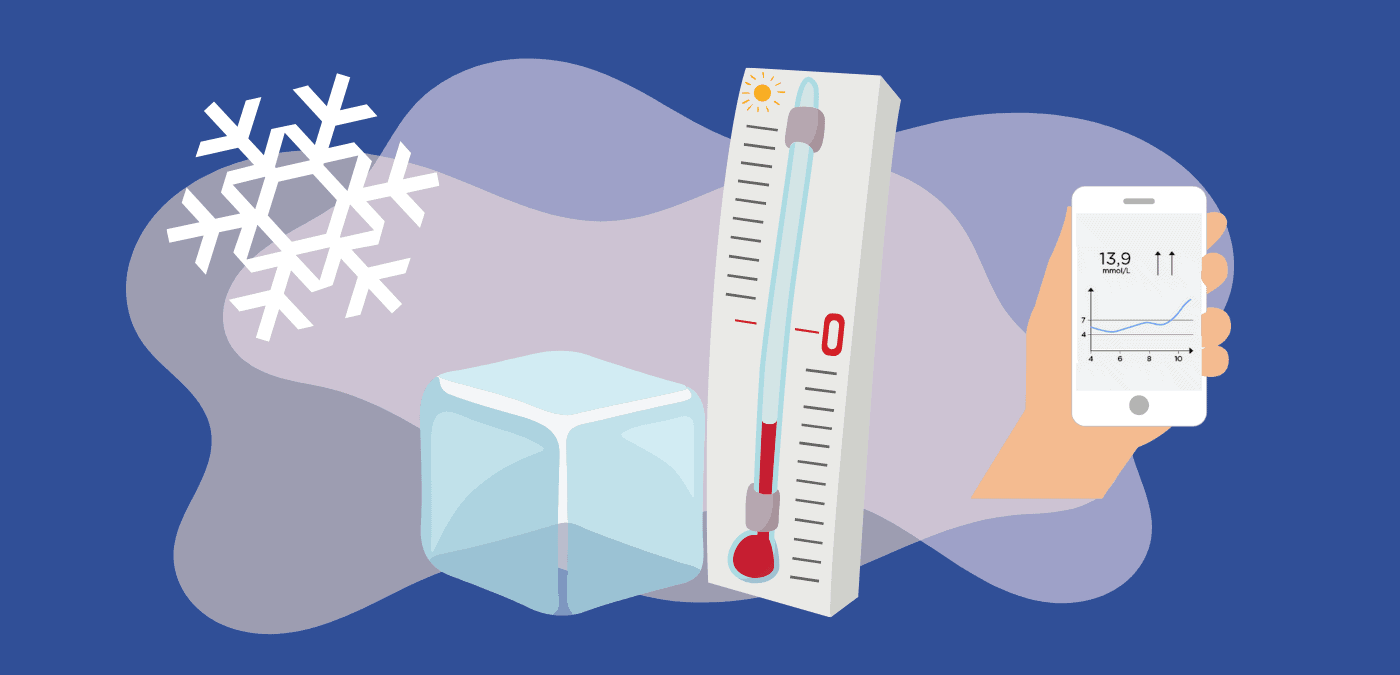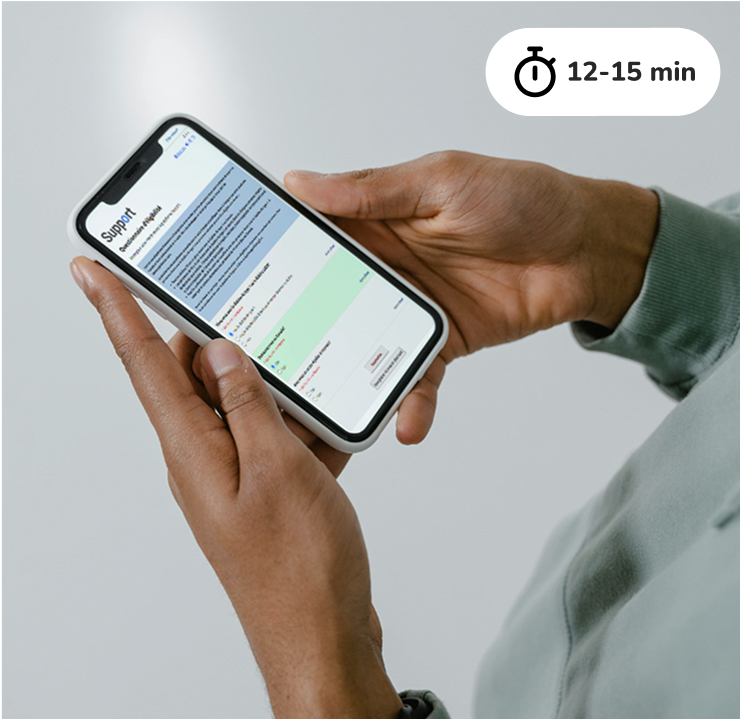Many women with type 1 diabetes (T1D) will agree: blood sugar levels and insulin requirements can fluctuate greatly at certain times during the menstrual cycle.
Several studies carried out in recent years confirm that sex hormones (estrogen and progesterone) could be yet another that can influence blood sugar levels. An increase of blood sugar levels has in fact been observed in many women between ovulation and the onset of menstruation.
It would therefore be helpful to consider the menstrual cycle when analyzing blood sugar levels and adjusting treatment for women living with T1D.
The menstrual cycle
A typical menstrual cycle starts on the first day of menstruation and lasts around 28 days, divided into 3 phases. During the follicular phase (the first few days), most hormones are relatively stable. Then, around day 14, eggs are produced and a peak in hormones occurs. This is called the ovulatory phase. Then, between days 14 and 28 (luteal phase), estrogen and progesterone levels remain higher than before ovulation.
Phases and hormonal profile of the menstrual cycle

- LH = luteinizing hormone
- FSH = follicle-stimulating hormone
The LH and FSH promote ovulation and stimulate the secretion of sex hormones by the ovaries.
Source : Toor, S. et al. (2023). Type 1 Diabetes and the Menstrual Cycle: Where/How Does Exercise Fit in? Int. Environ. Res. Public Health 20(4), 2772. https://doi.org/10.3390/ijerph20042772
When hormonal spikes mean blood sugar spikes
According to a number of studies on the menstrual cycle and T1D, blood sugar levels tend to rise during the second half of the cycle (ovulatory and luteal phases) due to the hormone spike, which may increase insulin resistance (i.e., the same dose of insulin is not as effective as usual to lower blood sugar levels).
Some women will then experience a significant drop in blood sugar levels at the start of menstruation, which is also when hormone levels drop. In both cases, studies found that adjusting insulin doses and the correction factor—or insulin sensitivity, based on which a correction bolus is calculated—helped to limit hyperglycemic episodes during the ovulatory and luteal phases, and to prevent hypoglycemic episodes at the start of the cycle.
Some researchers have also observed that during the luteal phase, progesterone accentuates the dawn phenomenon (a rise in blood sugar levels in the morning’s early hours). In these cases, the adjustment of basal insulin (by injection or pump) proved effective.
Several analyses have also shown that the percentage of time in range (between 4.0 mmol/L and 10.0 mmol/L) decreases between the beginning and end of the menstrual cycle.
Puberty and menopause
Studies have shown that women living with T1D are more likely to experience delayed puberty (1–2 years) and to have irregular periods.
And women with T1D generally have a shorter reproductive period and therefore enter premenopause slightly earlier (2 years) than women without T1D.
Identifying customized strategies
Studies suggest that women whose blood sugar levels are higher in the second half of the menstrual cycle would benefit from increasing their insulin doses during this period.
Those who use injections may need to increase their doses of both long- and short-acting insulin (for meals). Women using an insulin pump can set and activate a different program with increased basal insulin. Finally, users of hybrid closed-loop systems (artificial pancreases) certainly benefit from automatic insulin adjustments to counter hormone-related blood sugar fluctuations, although more studies are needed to demonstrate this.
One of the major difficulties for women living with T1D is that the impact of the menstrual cycle on blood sugar levels can vary from cycle to cycle, just as it seems to vary from person to person. What’s more, the effects of different contraceptives on blood sugar levels are not yet fully understood.
The relationships between phases of the menstrual cycle, fluctuations in blood sugar levels and insulin requirements need to be further investigated. The GLYMETY study, in Canada, aims to gain a better understanding of this important issue. This is an observational study over three menstrual cycles to collect data on blood sugar levels, insulin doses, menstrual cycle and premenstrual symptoms.
A better understanding of the impact of the menstrual cycle on T1D will make it easier for women and healthcare professionals to find strategies to help manage blood sugar levels.
To find out more: Hormones and type 1 diabetes webinar – Replay
References :
Muccioli, M. (2022). Diabetes and Menstruation: Insulin Requirements Throughout the Menstrual Cycle. Diabetes Daily. Page viewed on July 3rd, 2023. https://www.diabetesdaily.com/learn-about-diabetes/treatment/insulin-101/how-to-use-insulin/insulin-requirements-throughout-the-menstrual-cycle/
Toor, S., Yardley, J. E. and Momeni, Z. (2023). Type 1 Diabetes and the Menstrual Cycle: Where/How Does Exercise Fit in? Int. J. Environ. Res. Public Health 20(4), 2722. https://doi.org/10.3390/ijerph20042772
Cortés, M. E. and Alfaro, A. A. (2014). The effects of hormonal contraceptives on glycemic regulation. Linacre Q. 81(3), 209-219. doi: 10.1179/2050854914Y.0000000023
Diaz, J. L. et al. (2022). Insulin Replacement Across the Menstrual Cycle in Women with Type 1 Diabetes: An In Silico Assessment of the Need for Ad Hoc Technology. Diabetes Technology & Therapeutics 24(11), 832-841. https://doi.org/10.1089/dia.2022.0154
Gamarra, E. and Trimboli, P. (2023). Menstrual Cycle, Glucose Control and Insulin Sensitivity in Type 1 Diabetes: A Systematic Review. Pers. Med. 13, 374. https://www.mdpi.com/2075-4426/13/2/374
Mewes, D. et al. (2002). Variability of Glycemic Outcomes and Insulin Requirements Throughout the Menstrual Cycle: A Qualitative Study on Women With Type 1 Diabetes Using an Open-Source Automated Insulin Delivery System. Jour. of Diabetes Science and Tech. 17 (5), 1304-1316. https://doi.org/10.1177/1932296822108019
Tatulashvili, S. et al. (2022). Ambulatory Glucose Profile According to Different Phases of the Menstrual Cycle in Women Living With Type 1 Diabetes. The Jour. of Clin. Endo. and Met. 107 (10), 2793-2800. https://academic.oup.com/jcem/article/107/10/2793/6648857
Written by: Nathalie Kinnard, scientific writer and research assistant
Reviewed by:
- Sarah Haag, RN. BSc.
- Rémi Rabasa-Lhoret, M.D., Ph.D.
- Anne-Sophie Brazeau, P.Dt., Ph.D.
- Anne Bonhoure, M.Sc., Ph.D. student, IRCM
- Michel Dostie, Claude Laforest, Marie-Christine Payette, patient partners of the BETTER project





